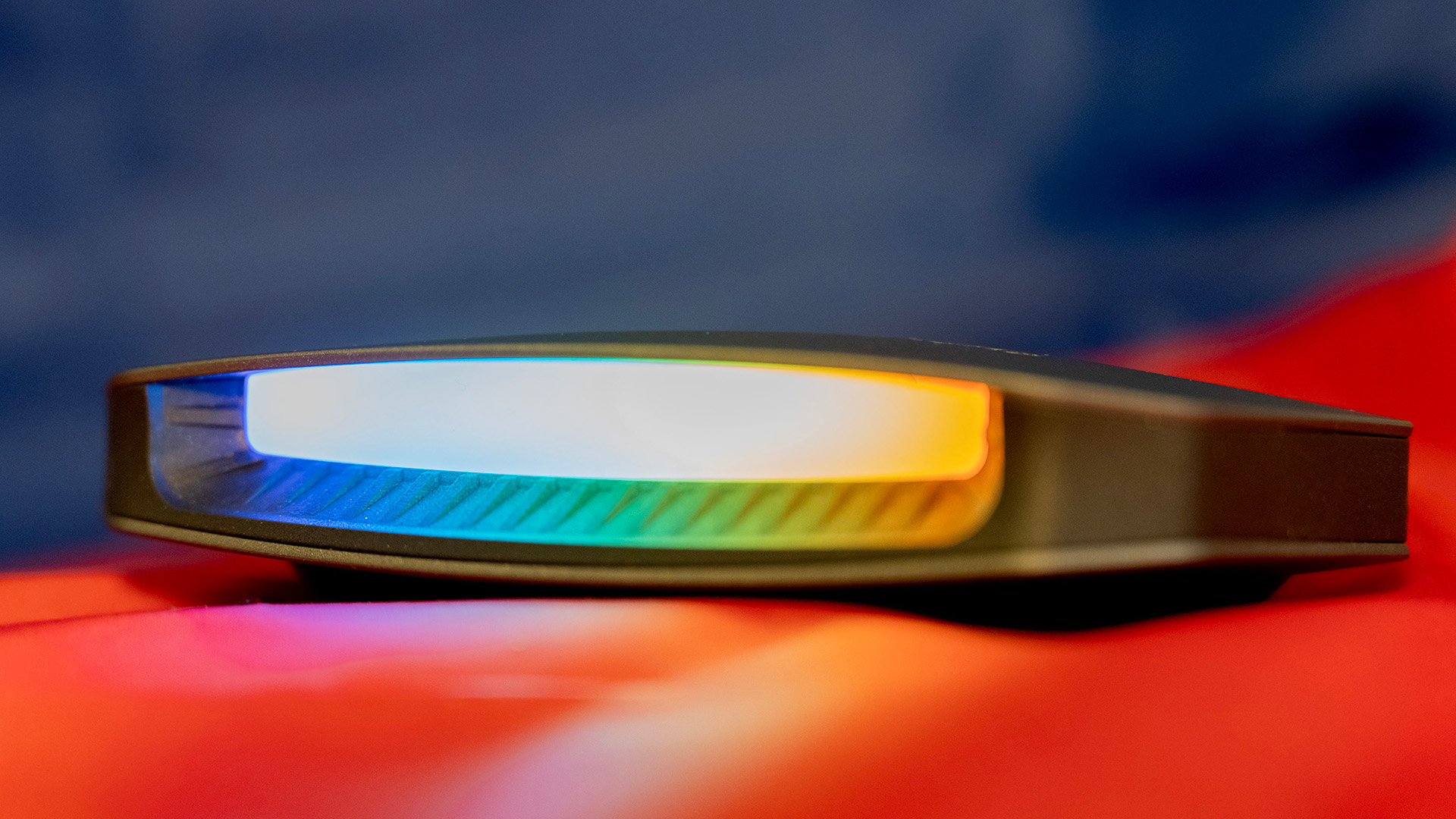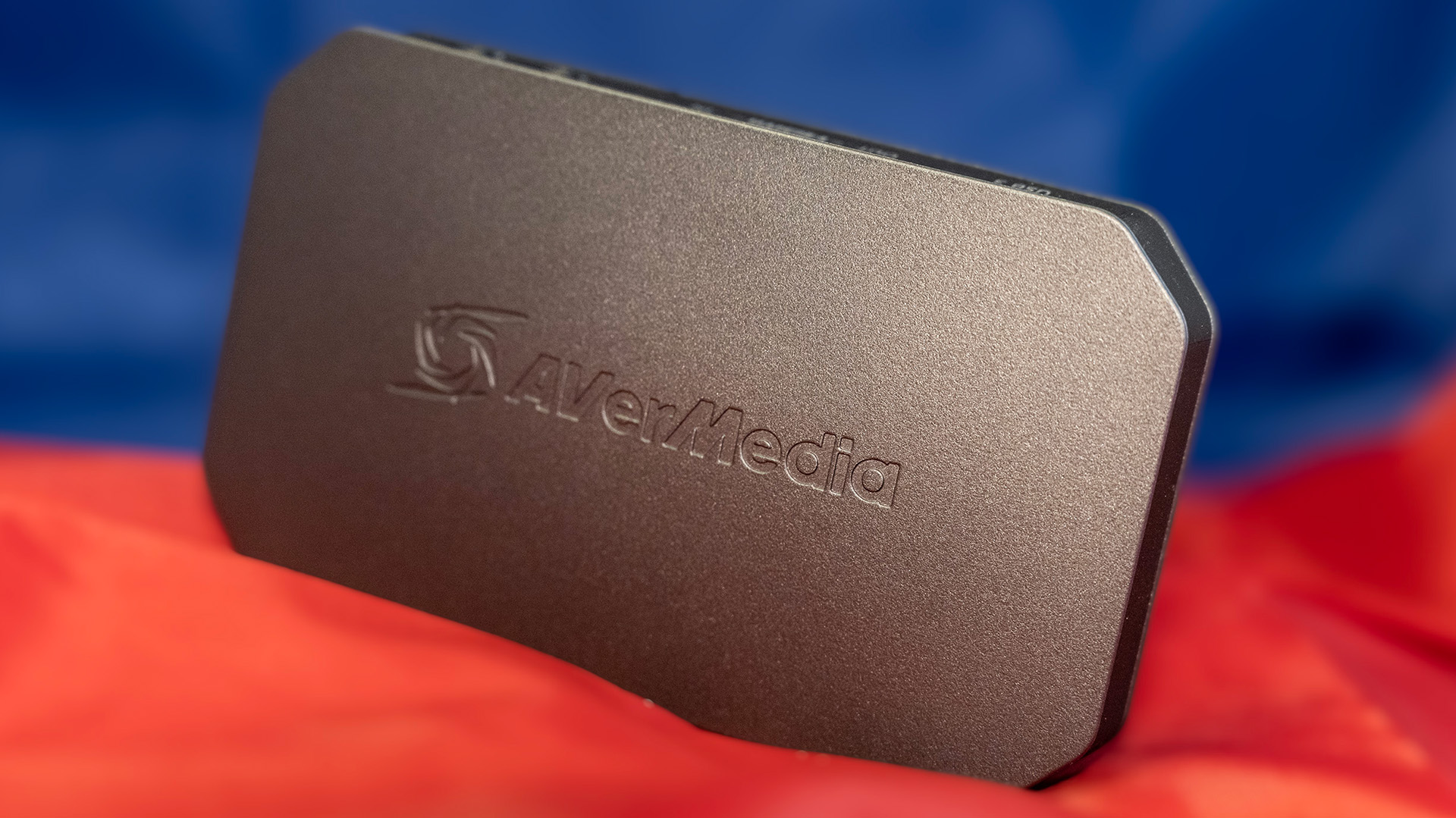Our Verdict
If you need HDMI 2.1 passthrough with your video capture, then this is just about your only option right now. Luckily, it’s intuitive, works straight away, and isn’t tied to a specific streaming app.
For
- Easy setup
- HDMI 2.1 passthrough, 4K/60 capture
- Compact and lightweight
Against
- Expensive
- Bright lighting strip
- Firmware a work in progress
PC Gamer's got your back
HDMI 2.1, along with all the neat tricks that standard brings with it, has taken a while to arrive on a consumer capture card despite having been available on modern PC GPUs and consoles for some time. AverMedia’s Live Gamer Ultra 2.1 is the first to offer the ability to pass high and variable frame rates through to a monitor while capturing, with no need to set your source to 60fps.
Even though we’re calling it a capture card, it’s a box. It connects to your PC via a single USB 3.2 USB-C port (or a 10Gbps Type-A port if you switch the cable—you’ll be restricted to 4K/30 if it’s a 5Gbps port) that supplies power and data rather than a PCIe slot, and it’s completely enclosed in plastic. There's an HDMI input for the source you’re capturing from, another for passthrough to a monitor, and 3.5mm jacks for a headset and a game controller if you’re using the type that has audio built-in and want to capture that too. That’s it, apart from a massive RGB light bar on the front that you’ll probably want to turn off. It’s not a large unit, and will be simple enough to slip in a bag or tidy away if you’re not a full-time streamer.
Setup is a cinch. Installing the software takes just a few seconds, and a firmware update took two minutes.
The card supports 2160p/144, 1440p/144 and 1080p/240 passthrough out of the box, and ours was using beta firmware that enabled 1440p/240 and 1080p/360 passthrough too, a stable version of which should be released nearer the end of October, and ultrawide 3440x1440p/100 capture will be added after that. Support for even more resolutions and frame rates will be added gradually, according to the AverMedia website.

Max Passthrough: 2160p144 HDR/VRR, 1440p144 HDR/VRR, 1080p240 HDR/VRR (1440p244 HDR/VRR, 1080p360 HDR/VRR will be added in a firmware update)
Max capture: 2160p/60
Size: 120 x 70 x 27.6 mm
Weight: 115 g
Requires: Intel Core i7 7700HQ plus GeForce GTX 1050 Ti or better, 8GB RAM, Windows 10 or 11 (MacOS support coming)
Price: $300/£280
Once running, it appears as a capture device in something like OBS Studio (AverMedia’s own RECentral, oddly, won’t get support until early 2024), and you can view the stream once you’ve configured it. An HDMI 2.1 monitor can be attached to the HDMI out port on the box, and it will pass through the full range of 4K, HDR, VRR, high refresh rate signals so you can play as smoothly as you want while capturing at a different rate. The maximum capture resolution via the USB 3.2 Gen 2 Type-C port is 4K/60, but higher 4K frame rates up to 144Hz will pass to the monitor.
Commendably, the whole thing worked flawlessly first time, with none of the head-scratching, or frantic unplugging and replugging of cables that typically accompanies any attempt to set up a chain of video devices. Every link in that chain needs to be HDMI 2.1 compliant, however, if you’re expecting to pass the signal cleanly through to a monitor, and you’ll need to disable HDCP or you’ll get a black screen with a message directing you to Avermedia’s FAQ.
USB-C, HDMI and four-pole 3.5mm cables are included in the box. It’s fairly likely users will have their own already, in a crate gathering dust under the bed, but it’s nice to see there's enough here for a first-timer to get started.

In the Avermedia app you can set independent volume levels for mics, headphones and controller audio, and choose the video resolution and frame rate you want to pass to the capture app and an external monitor. There are presets for consoles and mobile devices, and a generic ‘other’ for everything else. You can even bust it down to HDMI 2.0 or 1.4 if you’ve got a good reason to.
The RGB light bar has a use beyond merely lighting up the room you’re working in and needing to be turned toward the wall. It displays a rainbow pattern when everything is working, and flashes colour codes when it’s not. You can control it using third-party lighting software to sync it with whatever else you’ve got going on, or turn it off completely if it’s interfering with your camera feed and chroma key.

If you’re wondering why you’d need an HDMI capture card, box, device, whatever, then it’s because it’s the future, and pages of comments on the AverMedia website demanding to know when the device will ship suggest there's definitely a market out there. PCs have been supporting HDMI 2.1 since the GeForce 3000 series, and both the PS5 and Xbox Series X do too. It’s not just about HDR or 8K video, but higher refresh rates and features like VRR. Monitors that support such inputs may be thin on the ground, but if you’re interested in future-proofing your streaming setup, you’re going to need one of these.



Capturing video at 1080p/60 isn’t going to cut it forever, even for YouTube or Twitch, but what’s more important is being able to play games that rely on intense frame rates, such as competitive esports, at their best while capturing, without needing to make a compromise just because you’ve got the capture box connected, and that’s what the AverMedia box supplies with its HDMI 2.1 passthrough. Capture at 4K has largely been the preserve of PCIe cards, so having the capability in an external box that connects via USB opens up SFF PCs and laptops as viable high-end capture platforms.
The Live Gamer Ultra 2.1 is twice the price of an Elgato capture solution, or even Aver’s own 4K box, at $300/£280. That's a heck of a lot more than some generic USB capture kit from a popular online retailer, so you’ll really have to need those HDMI 2.1 features to even consider buying one. There is an argument for having them, however, if 144Hz gaming matters to you and your viewers, and there's always something to be said for having top of the range, future-proof gear.
If you need HDMI 2.1 passthrough with your video capture, then this is just about your only option right now. Luckily, it’s intuitive, works straight away, and isn’t tied to a specific streaming app.

Ian Evenden has been doing this for far too long and should know better. The first issue of PC Gamer he read was probably issue 15, though it's a bit hazy, and there's nothing he doesn't know about tweaking interrupt requests for running Syndicate. He's worked for PC Format, Maximum PC, Edge, Creative Bloq, Gamesmaster, and anyone who'll have him. In his spare time he grows vegetables of prodigious size.


